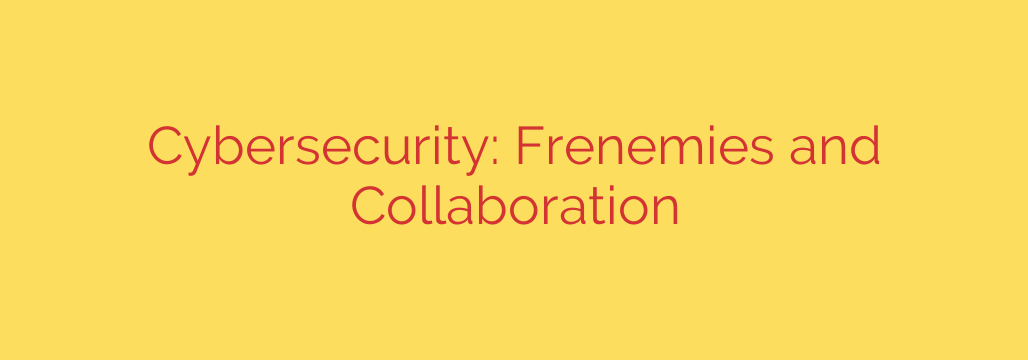
The Cybersecurity Paradox: Why Your Biggest Competitor Might Be Your Best Ally
In the high-stakes world of digital security, the traditional lines between friend and foe are becoming increasingly blurred. The conventional wisdom of business—guard your secrets and outmaneuver the competition—is being turned on its head by a far more dangerous, common enemy: the sophisticated cybercriminal. Today, the most effective defense strategy isn’t built in isolation. It’s built on an unprecedented level of collaboration, even with direct competitors.
This new paradigm is often called the “frenemy” dynamic. While companies still compete for market share and clients, they are realizing that a security breach against one is a potential threat to all. The attackers, after all, are not playing by any rules. They collaborate in dark web forums, share attack tools, and sell vulnerabilities to the highest bidder. To combat this unified front, the defenders must also unite.
The Old Walls Are Crumbling: Why Isolation Fails
For years, organizations operated under a “castle-and-moat” security model. The goal was to build an impenetrable digital fortress and keep everyone else out. However, this approach is now dangerously obsolete. Modern cyber threats are not simple attacks against a single wall; they are complex, multi-stage campaigns that can exploit supply chains, third-party vendors, and industry-wide vulnerabilities.
When a company detects a new type of malware or a clever phishing technique, keeping that information secret provides only a temporary, fragile advantage. Meanwhile, the attackers are free to use that same technique on a competitor, refining their methods until they can circle back and breach the original company’s defenses. A siloed approach to security only gives threat actors more time and more targets to practice on.
The Power of Collective Defense: How Collaboration Works
True cyber resilience in the modern era is rooted in the principle of collective defense. This involves a structured and trusted exchange of information between different organizations, including rivals, government agencies, and security researchers.
The core idea is simple: if one organization is targeted, the intelligence gathered from that attack can be used to protect everyone else. This creates a powerful network effect where the entire ecosystem becomes stronger and more resilient with every piece of shared data.
Key pillars of this collaborative model include:
Sharing Threat Intelligence: This is the most crucial element. It involves sharing indicators of compromise (IoCs) like malicious IP addresses, file hashes, and suspicious domain names. When this information is shared in real-time, it transforms cybersecurity from a reactive, forensic exercise into a proactive, predictive defense. Companies can block an attack before it hits them because they were warned by a peer.
Public-Private Partnerships: Government agencies, like the Cybersecurity and Infrastructure Security Agency (CISA), play a vital role in facilitating information sharing. They can provide classified intelligence to private companies and act as a central hub for coordinating responses to large-scale national or international cyberattacks.
Information Sharing and Analysis Centers (ISACs): These are industry-specific organizations that create a trusted, non-competitive environment for companies to share sensitive security information. For example, the Financial Services ISAC (FS-ISAC) allows banks and financial institutions to anonymously warn each other about fraud schemes and cyber threats unique to their sector.
Overcoming the Trust Deficit
Of course, this level of cooperation doesn’t happen overnight. The primary barriers are trust, liability, and the fear of revealing a competitive disadvantage. Companies worry that sharing information about a breach could damage their reputation or that a competitor might use their security weaknesses against them.
However, the industry is maturing to overcome these hurdles. Frameworks for anonymized data sharing, clear legal protections, and the proven success of ISACs are helping to build the necessary trust. Leaders are recognizing that the reputational damage from a major, preventable breach is far greater than the perceived risk of collaboration. Ultimately, the risk of going it alone in today’s threat landscape far outweighs the risk of strategic cooperation.
Actionable Steps for a Collaborative Security Strategy
Integrating a collaborative mindset into your security posture is no longer optional. Here are a few practical steps your organization can take:
- Join Your Industry’s ISAC: This is the single most effective step. It provides immediate access to a trusted community and a firehose of relevant, actionable threat intelligence.
- Utilize Open-Source Intelligence: Participate in and consume data from open-source threat intelligence platforms. This allows you to contribute to the community while benefiting from its collective knowledge.
- Foster a Culture of Sharing: Encourage your security team to participate in industry conferences, working groups, and forums. Building personal relationships with peers at other companies is foundational to building trust.
- Establish Clear Protocols: Develop internal policies for what, when, and how your organization shares threat information. Ensure these protocols align with legal and compliance requirements.
In the end, cybersecurity is not a zero-sum game. A win for a threat actor against any organization is a loss for the entire digital ecosystem. By embracing collaboration and viewing competitors as essential allies in the fight against cybercrime, we can build a stronger, more resilient, and collectively defended future.
Source: https://www.paloaltonetworks.com/blog/2025/08/cybersecurity-frenemies-collaboration/








